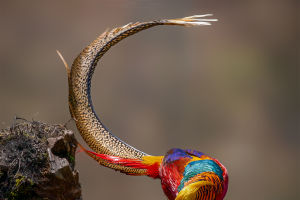Beautiful Bird
The white-bellied kingfisher is 14 cm long, the female weighs 14.5 grams, and the male weighs 14.7 grams. The plumage is gorgeous and radiant, with a blue color. It is roughly the same size and appearance as the crested kingfisher, but with a white belly and uncrowned feathers on its head.
The front of the cheeks is red and the rest of the head is blue. The tail is dark blue and shiny. The mouth is reddish-orange and the iris is dark brown.
The common kingfisher has bluish-black forehead to occiput with dense emerald-blue horizontal spots, bright emerald-blue back, chestnut-brown belly, light horizontal spots on top of head, red beak and feet.
Difference in distribution.
The white-bellied kingfisher is found in central and southern Africa (including the southern Arabian Peninsula and the entire sub-Saharan African continent). The common kingfisher has a wide range.
Habits of the white-bellied kingfisher.
Habitat.
Inhabits thickets or sparse forests, dry forests with low vegetation, rivers, swampy mangroves, streams, lakes, gardens, coconut plantations, ponds.
Activity.
It usually lives alone on branches or rocks near the water's edge.
Food.
On the branches or rocks by the water, wait for the opportunity to hunt, mainly eat small fish, eat insect larvae, beetles, beetles, termites, ants, wasps, spider crabs, earthworms.
Ability.
After the kingfisher dives into the water, it can maintain excellent vision, because its eyes can quickly adjust the viewing angle contrast caused by the light in the water after it enters the water. So the fishing ability is very strong.
Nest.
Nests are built on soil cliffs, or on the banks of fields and streams, with tunnel-like burrows dug with their mouths as nests. These caves are generally not paved.
Breed.
Eggs are laid directly on the nest floor. Usually two eggs are laid at a time.
Eggs are pure white, slightly spotted, about 28 mm × 18 mm in size, 1 to 2 litters per year. The incubation period is about 21 days, and the male and female incubate the eggs together, but only the female bird feeds the chicks.
Why are kingfishers increasingly rare?
1. Food shortages. Many wild glasses of water have been depleted. Humans catch, and kill fish of all sizes. And once the kingfisher consumes the lethal fish, it shares the same end as the fish—death.
2. Petitioning Because of their stunning plumage and decorative look, kingfishers are frequently kept as pets. Due to its unusual ways of life, feeding is challenging; as a result, many caught kingfishers succumb to starvation.
Where have you seen this bird?


